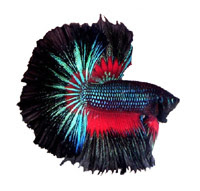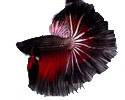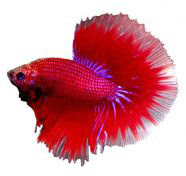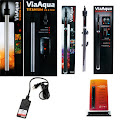Our Facebook Page to Follow: Aquarium/Pond Answers Facebook
This is a unique resource for answers, help, & advice to aquarium and pond questions not found elsewhere; With regular posts & article updates.
In our research; we use aquaculture, horticulture, medical, & university research to compile many of our articles.Our Recommended Lighting for highest efficiency professional planted/reef aquariums: "AquaRay Lighting"
TB in Fish, Mycobacterium Tuberculosis; Bettas & more
By Carl Strohmeyer-PAMR 40+ years experience
Updated 9-25-19
 Fish Tuberculosis is generally caused by Mycobacterium marinum, a bacterium closely related to the human TB (Tuberculosis) bacteria, Mycobacterium tuberculosis, although incidents of Mycobacterium triplex have also been reported with Bettas.
Fish Tuberculosis is generally caused by Mycobacterium marinum, a bacterium closely related to the human TB (Tuberculosis) bacteria, Mycobacterium tuberculosis, although incidents of Mycobacterium triplex have also been reported with Bettas.
Despite some internet claims, based on my many years of "house calls" and other professional aquarium maintenance work has shown Fish "TB" to be relatively uncommon with the exception of cases where the bacteria has been passed around and the fish' immune system has been compromised, this is especially the case with recently confirmed Mycobacterium triplex.
This seems to be more common among breeding and showing circles/clubs where water equipment cross contamination is common.
The above said, be careful about assuming your fish have Fish TB, unless all symptoms are present and treatment for more likely infections have failed.
However Bettas and Gouramis for reasons not 100% known seem to be more susceptible or have been placed in conditions where tuberculosis is more likely to overcome the fish' immune response.
Please read the "PREVENTION" section for more about TB in Bettas in particular
Treatment for Mycobacterium tuberculosis is often long and not always successful, as well low fish immunity due to poor aquarium parameters (including Redox Balance), along with fish age or even simple stress from tank mates can add to treatment difficulties or make treatment impossible (especially since Fish TB is difficult to treat anyway)
ADVERTISEMENT
A myth I have seen written in a few "circles" (for some reason I have found this myth especially common on certain Betta Forums), is that Fish TB can also cause full blown human TB which is simply not true (only mild localized infections in healthy adults humans).
However it is still best to avoid fish to human transmission, especially if your immune system is compromised in any way.
Generally when the Mycobacterium marinum bacteria infects humans it is a dermatological issue as the bacterium usually enter the skin via small abrasions or cuts when you are performing aquarium maintenance.
The symptoms in humans are usually restricted to skin and soft tissue destruction in most instances of Mycobacterium marinum infection via small purple lesions that can gradually grow. It is noteworthy that in my decades of professional aquarium maintenance with literally 1000s of aquariums, I have only noted a couple of proven fish to human TB transmissions, so be careful of alarmist web sites.
Another myth about Fish TB, especially since it seems to have become the aquarium fish disease "De Jour" (disease of the day), is its transmission.
Based on emails, phone calls and discussions with my maintenance friends, you would think every fish that is sick now suddenly has this disease.
While it certainly seems to be more common and virulent as per confirmed cases, it is NOT commonly present in an aquarium (unlike Aeromonas, Columnaris, or Pseudomonas bacterium).
So in the case of fish that have been living in an aquarium for months and often years without any outside exposure to other fish, the facts are it is impossible for the fish to suddenly come down with a Mycobacterium infection!
Usually this false diagnosis with no history of possible exposure is simply the result of a simply weak or old fish showing symptoms that are often common to Fish Mycobacterium (TB).
What is also very noteworthy with a fish that may be showing symptoms common to Mycobacterium, if the fish dies within days of the first symptoms, it is VERY LIKELY that your fish did NOT have Mycobacterium as generally Mycobacterium kills slowly!!
Even with potential exposure, in my experience with confirmed cases of Mycobacterium, transmission usually ONLY happens in aquariums with old, genetically weak, injured, or with poor tank water parameters (which includes a poor aquarium Redox Balance).
In other words, under normal conditions this is not a highly contagious fish disease!
Then as per poor water conditions, genetically weak, poorly fed, etc. fish, it is more likely the fish have another bacterial infection and correcting these conditions is job one. Most common with Bettas in particular is lack of mineral Cations resulting in poor osmoregulation and increased oxidative stress (poor Redox balance)
Identification:
If staining for identification, Mycobacteria stain bright pink against a blue background (as these bacterium are acid fast).
However, most aquarium fish keepers do not have the ability to grow cultures or make slides; so the symptoms of Fish TB are usually wasting away, lesions on the fish' body, loss of scales and/or coloration, and especially skeletal deformities such as curved spines.
 The Betta fish in the picture above (please click to enlarge) displays classic symptoms of Fish TB in finage, skeletal deformity, and wasting to the point light can slightly penetrate her abdomen as seen in the light spot.
The Betta fish in the picture above (please click to enlarge) displays classic symptoms of Fish TB in finage, skeletal deformity, and wasting to the point light can slightly penetrate her abdomen as seen in the light spot.
From Testing for "Fish TB"; AquariaCentral
The fish to the right is a largemouth bass showing clinical signs consistent with
mycobacteriosis; note the ragged fins, sores, and general deterioration of the fish, differing from more common fish diseases such as Aeromonas and Columanaris.
Mycobacterium triplex can only be identified by 16S rDNA sequencing, so positive identification is difficult.
Treatment:
As with ANY fish disease, always start with getting your aquarium water parameters in order (as well as feeding), which in most my client house/office calls over the years with TB or copycat fish diseases this was a major issue.
Reference this article for more in depth help here:
A Healthy Aquarium, Fish Disease Prevention
Mycobacterium marinum
Time of Treatment is VERY long and is generally administered for at least three months. Cure rate is well under 50%, but also do not believe those who state it cannot be cured as I have many times.
A hospital tank treatment is advised for fish TB since this generally is a very long treatment regimen and a three month treatment of ANY antibiotic can result in serious damage to your aquarium bio filter.
The three most proven antibiotic methods, which can and should be used in a combination of two of these drugs along with the other described alternative treatments:
*Kanamycin (Kanaplex)
*Neomycin
*Isoniazid (from Aquarium Medications Part 2)
Sometimes a Sulfamethazine/Trimethoprim Combination can be effective too.
Resource:
*Sulfamethazine/Trimethoprim Combination (sometimes effective)
Often a "cocktail" of these medications along with a fish bath (mentioned next) is needed for any hope of success, which can be very harsh on the aquarium environment. So unless the infection is systemic, a hospital tank might be best (adding a TRUE level one capable UV Sterilizer to your main tank is suggested to check spread, see later in the prevention section of this article.
A fifth consideration, albeit less field tested (it does show lab results though) is Usnea, which from my experience should only be administered in a "Fish Bath" form for 30 minutes. Methylene Blue should also be used in this bath, but no other antibiotics should be used in this bath with Usena.
These baths can be rotated; meaning one bath with Usena and Methylene Blue and the next bath with MB along with one or two of the other antibiotics, then back to the Usnea
Usnea is best as a used as a bath ALONG with an in tank treatment with one of the first three noted medications (or better hospital tank).
Further Information: Organic Fish Treatments; Usnea
A sixth consideration is Allicin, the active ingredient in RAW Garlic. Mycobacterium marinum) has been demonstrated to be effectively treated with Allicin, at least in vitro.
SeaChem Garlic Guard can be used in a fish food slurry preparation and mixed with both Neomycin and Kanamycin for improving the potential effectiveness of tuberculosis treatment.
See: Fish Nutrition; Garlic
Recommended Product Resource:
Garlic Guard; for Fish TB, Appetite Enhancer
A final consideration that might be helpful, in particular if the diagnosis is INCORRECT (which is common), is the use of Medicated Wonder Shells. These address many aspects of fish health, including problems that are simply symptoms of fish old age and not any disease in particular.
While a Medicated Wonder Shell is not a strong treatment for any particular disease, these are helpful as both follow up treatments and mild treatments that also address essential water parameters that might be out of balance (such as Redox).
Recommended Product Resource:
Medicated Wonder Shells
Back to Fish Baths; regardless of the medication or combination of medications used in tank, I suggest a Fish Bath with one of the first four before mentioned treatments (not garlic) at least once per day during this time period.
In fact in some cases the fish baths were all that was needed for success assuming these were carried out regularly.
Now for the bad news, from experience and others, once the fish became emaciated I had little to no success saving them.
Please Read/Reverence these Articles:
*Aquarium Medications; How Medications Work, and Which Ones to Use and Not to Use
*Fish Baths, How to Perform
Treatment of Mycobacterium triplex (not M. marinum) in human studies has shown it to be nearly impossible with only reduction of symptoms, not eradication of the bacterium.
These treatments used levofloxacin, ethambutol, and clarithromycin; all of which NOT available in fish medications.
You best bet with this rare strain (assuming your fish even has it), is to sadly euthanize and sterilize EVERYTHING, then start over.
How NOT to Treat:
The use of salt either in baths or in the aquarium will have absolutely no affect on Mycobacterium tuberculosis since this bacterium thrives equally well in salt or freshwater.
Temperature increases or decreases have little effect and in fact a temperature increase over 30°C. (as with Columnaris) often worsens a Mycobacterium tuberculosis infection.
Temperature decreases has shown some anecdotal slowing of the progression of Mycobacterium tuberculosis, but no cure.
Prevention:
There is not a 100% proven way to prevent Aquarium Fish Tuberculosis (as with most pathogens), however based on my own observations going back to 1977 (working at a Pet Store Fish department and then my aquarium maintenance company), I definitely noticed patterns.
Emails from customers and questions I see asked in forums and elsewhere have added to this same pattern.
Here are a few known factors:
- High organic loads, water quality characteristics common in intensive systems, and very crowded populations can all exacerbate the infection.
- Feeding feeder fish, fish remains, fresh worms and similar. Better if fish TB has been a problem a truly top notch prepared fish food such as Clay Neighbor's AAP Custom.
- One pattern is what I noted earlier and that is Bettas and Gouramis have a higher incidence of both suspected and proven cases of Mycobacterium marinum Tuberculosis infections.
I also noted that certain vendors (wholesale suppliers) would have a higher incidence of TB infected fish, so avoiding the purchase of fish from places that you have suspected TB on numerous occasions may also be helpful; this said, do NOT write off a retailer or vendor based on 1 or 2 suspicions of Fish TB, as it may have been another disease pathogen, as well frankly no vendor/retailer is perfect!.
Also be careful with Betta shows or similar, as I believe that this is both a major stressor AND infection point. - As for procedure you can do to prevent Fish TB infections; there are many.
The most obvious is as stress free an aquatic environment as possible since stress due to many factors seems to be a major factor based on my work and research.
This includes stress from water conditions and tank mates.
Changing water regularly, maintaining a stable pH & KH, near 0 ammonia (NH3) and nitrites, a balanced Redox and ESSENTIAL aquarium positive mineral ions.
Further References:
*Aquarium Cleaning
*Aquarium Chemistry; In Depth, from Beginner to Advanced
*Aquarium Redox for Fish Immunity, Health
The use of Aquarium UV Sterilization with a correctly applied UV Sterilizer performing at Level 1 Sterilization (this will NOT and CANNOT be achieved with the many low end UV Clarifiers such as the Green Killing Machine, AquaTop Hang On and similar water clarification ONLY devices flooding the market!).
The correct use of a UV Sterilizer can aid in Redox Balance and in the end also aid in fish immunity and is a MUST for an aquarium with a history of Fish TB to check the spread based on my extensive experience with Fish TB and true UV Sterilizer use.
MUST READ Reference:
Ultraviolet Sterilization, Facts & Information; Including Level 1 & 2
Recommended Product Sources:
Level 1 & 2 UV Sterilizers
Clay Neighbor's AAP Custom Super Premium Fish Food; Far Ahead of any other!
The use of SeaChem Garlic Guard or similar in fish food can also be used in an ongoing basis to improve fish health and prevent Fish Tuberculosis.
Back to Bettas in particular, a problem I have seen based on patterns that are almost 100% identical and that is many Betta Forums and Clubs will pass around the same methods of Betta keeping that can increase the likelihood of TB infections.
This includes constant chasing of pH, 100% water changes, keeping of Bettas in very small closed environments, lack of positive mineral ions essential to immune response, passing around fish (with constant exposure and stress), and limited gene pools due to interbreeding.
My suggestion is to keep your Betta in a system with a larger volume of water with small individual containers.
Within this system these practices can aid in TB prevention:
- Good bio filtration with quality sponge filters, or even better Fluidized Sand Bed filters, use of products such as SeaChem Purigen to further "clean" the water.
Product Resources:
*AAP High Capacity Hydro Sponge Filters
*AAP Premium Fluidized Sand Bed Bio Filters
*SeaChem Purigen; Clears Water of Dangerous Toxins - Maintenance of a stable pH & KH with as little of an effort as possible using products such as Alkaline Buffer, Acid Buffer, Driftwood, Pillow/Frog Moss, blended RO Water; IF NEEDED!
Product Resources:
*SeaChem Alkaline Buffer
*Zoomed Frog (Pillow Moss) for Natural Water Softening - Constant drip of ESSENTIAL mineral ion replenishing products such as SeaChem Replenish, or BETTER and more simply with AAP Original Wonder Shells This is one of the major causes of symptoms of Fish TB as the lack there of results in poor osmoregulation and higher oxidative stress.
As well to not be overly concerned with GH.
Further Reference: Aquarium Chemistry, GH
Product Resource: AAP Wonder Shells, Mineral Supplement, Unique Version - Do NOT pass your fish around in environments out of your control and attempt to bring new fish into your breeding operations from sources you are not 100% sure of.
- Utilize a GOOD Level 1 UV Sterilizer such as the TMC Vecton. Do not fool yourself into complacency with one of the many UV Sterilizers sold for under $50 via Amazon or similar discounters, as there is not a one that can perform level one Sterilization (most do not have HO UV lamps and are missing pre-filters that are required)!!.
Reference:
UV Sterilization; Water Flow for Level 1
Buying Aquarium Products via Amazon (& Chewy, eBay)
Product Resource: TMC Vecton Premium High Dwell Time Aquarium, Ultra Violet Sterilizer
If you are breeding Bettas, keeping the Bettas within isolation boxes/containers with a much larger 'cubical based centralized system' is a practical way to utilize a good UV Sterilizer, as well as maintain much better water quality.
The picture below displays aquarium cubicals that I highly suggest for anyone serious about breeding bettas so as to be able to maintain more stable water quality and also utilize UV Sterilization!

These cubicals can be placed in larger aquarium and can also be blacked out to prevent interaction between Bettas.
However the cubicals do allow for interaction of "smell". My suggestion for this is to keep certain Bettas at different points in their breeding cycle together in the same aquarium system (in other words multiple systems
See also the articles below in the references/resources dealing with Aquarium Disease Prevention for more help in Fish TB prevention
Further References/Resources:
*Mycobacterial Infections of Fish
*http://www.aquariacentral.com/forums/showthread.php?220754-Testing-for-quot-fish-TB-quot-pics-included
*Fish Diseases; Univ. of Florida
*Aquarium Disease Prevention; Proven Steps
*Mycobacterium triplex Pulmonary Disease in Immunocompetent Host
By Carl Strohmeyer
Copyright 2019
Other Suggested Resources, Products
*
AQUARIUM AND POND INFORMATION;
Well researched and up to date aquarium and pond answers, help, and links
*Columnaris in Aquarium Fish (also Fungus)
This is easily the most in depth and regularly updated on the subject of Columnaris and Fish Fungus to be found ANYWHERE on the Internet!
*The Aquarium Nitrogen Cycle
The most up to date article on the subject of the Aquarium Nitrogen Cycle, based on both research and 35+ years of professional experience with 1000s of client aquariums!
*
UV Sterilization
This article covers many aspects of Aquarium & Pond UV Sterilization from how, why, facts, myths, and maintenance including the importance of changing UV Bulbs regularly.
*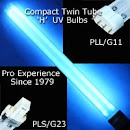
UV Bulbs; Page 1
As noted above, changing these PREMIUM bulbs/lamps every 6-12 months is essential for a properly functioning UV Sterilizer
*Aquarium Silicone Sealant; USDA 100% Fish Safe
100% Fish Safe, USDA & Agricultre Canada approved, the same CANNOT be said for Hardware Store brands!
Excellent for building aquarium systems of multi-tier fish housing.
*
Aquarium Lighting; Basic, Reef, Planted
The above referenced article is easily the most in depth and regularly updated on the subject of Aquarium Lighting to be found ANYWHERE on the Internet!

Atison's Spa Clear; Indian Almond Leaf Conditioner
Clear Betta Spa contains wild almond leaf extract to simulate the natural environment of the native soft water fish.
Other natural botanicals, including Yucca extract, help control ammonia, reduce stress and maintain cleaner water.
 FISH AS PETS
FISH AS PETS
Fish as Pets with articles & commentary of Interest to the Aquarium Hobby
*Planaria & Detritus Worms in Aquarium; Which is Correct?
ADVERTISEMENT
Labels: Aquarium Fish TB, Betta, Betta Tuberculosis, emaciated fish, Fish TB, Fish Tuberculois, Mycobacterium marinum, Mycobacterium triplex, sick fish
Betta Habitat; "Betta splendens" Wild Habitat
By Carl Strohmeyer-PAMR 40+ years experience
Updated 1/15/19
 I am writing this Aquarium Answers post/article to hopefully help with all the controversies around the internet and elsewhere about wild Betta habitat and requirements.
I am writing this Aquarium Answers post/article to hopefully help with all the controversies around the internet and elsewhere about wild Betta habitat and requirements.
I would like to qualify this and state that as with many popular aquarium fish (such as Angels and Discus), the domestic versions are often adapted to the environment that they have been bred for. In other words, many angelfish are originally from low pH waters but are now commonly bred in higher pH alkaline waters.
In the case of Bettas, these amazing fish come from a Tropical Habitat that is known for drastic swings in water availability, clarity, parameters, and even temperature. This makes for a fish that is naturally uniquely adaptable to a variety of aquarium environments and is in part a reason for their popularity.
This said, often Betas are forced to adapt to conditions that would better described as just surviving as many take advantage of this fish' amazing adaptation abilities to extremes that they rarely face in the wild.
River Drainage Basins and natural environment
The Chao Phraya River drainage is seen in the central Thailand area of the map while the Mekong River Drainage habitat is seen in Cambodia and Eastern Thailand
The Betta is a native freshwater fish from Thailand (formerly Siam) and Cambodia (formerly Kampuchea). Most native Bettas originate from the Mekong AND the Chao Phraya River drainage basins. These drainages are mountainous with agriculturally productive valleys found in the upper regions.
The lower region contains alluvial plains that are highly productive for agriculture. The Mekong and Chao Phraya Rivers drains from north to south.
Monsoon weather dominates, with a rainy season lasting from May to October and supplementary rain from occasional westward storm depressions originating in the Pacific.
Temperatures range from 15°C (59 F) in December to 40°C (104 F) in April except in high altitude locations. The basins can be classified as a tropical rainforest with high biodiversity. The lower parts have extensive irrigation networks and hence intensive rice paddy cultivation.
These rivers have a pH of 6.9 ranging to 8.2 and the nutrient level is low. In the Lower Mekong and Chao Phraya areas the river is turbid, especially during the rainy season.
With the very wide temperature swings it is easy to extrapolate that a betta can and will do well in a reasonable warm aquarium aquarium/large-bowl environment that does not exceed the temperature extremes found in the wild. This is not to say that a heated stable environment is not better for a healthy Betta (remember this IS a tropical fish).
The pH, GH, and KH also have wide swings, to which the Betta has adapted, however keep in mind that rapid changes in pH can still harm or even kill a Betta and should be avoided.
It is also note worthy that the pH scale is logarithmic, so a full point change in pH is tenfold increase or decrease in pH.
Please see this article for more about this subject:
“Aquarium Chemistry, GH, KH, Electrolytes, and pH in Aquariums”
ADVERTISEMENT
The low water nutrient levels of these rivers lend themselves to a reducing Redox and lower nitrate levels, which means frequent partial water changes are important with bettas and if breeding on a large scale, a system in which the breeding sections are all linked to a large central system with a UV Sterilizer is also useful for both disease prevention and Redox (but not essential).
See this article for more about UV Sterilization:
How UV Sterilization Works in Aquariums and Ponds
Where to get: UV Sterilizer
Further Redox Info: Aquarium Redox
Being an anabantids, Bettas have a labyrinth organ in their heads that allows them to take oxygen directly from the atmosphere in addition to the oxygen taken from water via their gills which allows them to cope with the dry season in their monsoonal climate home.
All of the above environmental adaptation as well as breeding adaptation is why the Betta survives well in a small tank or even a reasonably sized bowl (with filtration), but also make no mistake about it the Betta merely survives the dry season and its harsh realities of water quality, so providing your domestic Betta a heated, stable, regularly maintained tank, with proper electrolyte levels (even if under 2 gallons) will go a long way in long term Betta health.
 Although these beautiful fish were not seen in Europe until the 1800's, they have been cultured and kept in Thai households since the 1200's.
Although these beautiful fish were not seen in Europe until the 1800's, they have been cultured and kept in Thai households since the 1200's.
Bettas common aquariums have undergone centuries of selective breeding and have become far more aesthetically pleasing than the original Wild Betta, these “Domestic” bettas have also been adapted to the small aquarium environments in which they are often bred.
In the wild Bettas generally grow to 6.0 cm (2.3 in.), however many are now bred up to 8.0 cm (3.5 in.) in length.
A Bettas diet in the wild generally consists of insect larvae such as mosquito larvae. It is noteworthy that many of these insect larvae feed themselves on green organic matter, so a proper diet should consist of food that duplicates the digestive contents of these larvae as well.
Betta fish can live for up to 8 years in the wild, but this is rare with all the risks they also face in the wild. However, the average lifespan of a Betta fish is closer to 4 or 5 years in captivity under good care in a filtered tank with good nutrition, and proper chemistry (which includes positive mineral ions, which many Betta Keepers miss the scientifically proven importance of these electrolytes).
In Summary;
Take from this article which you as per the facts when it comes to how you house your Betta, however please keep in mind that even with smaller containers; utilizing an "under bowl/tank" ambient heater such as the Hydor Mini Bowl Heater is still needed to keep the Betta water temperature at least 60F (higher is better), partial water changes, maintaining ESSENTIAL positive mineral ions, limiting exposure to life threatening or lifespan shortening ammonia/nitrite levels by cycling your Bettas Aquarium Bowl are ALL still important as with any other fish regardless of aquarium size.
Product Source: Hydor Heater Designed Specifically for Bowls
What is more subjective is the size of the container you keep your Betta in assuming all the above objective/factual qualifications are met.
The argument is often made that a Betta is more happy in a larger aquarium, unfortunately unless you can speak to your Betta, this is simply an opinion.
From my observations with Bettas in 10 gallon or larger tanks versus Bettas I have kept in bowls (2 gallons plus, NOT Vases!), I have noticed often much more lively Bettas in the Bowls than in the larger aquariums where by they often hide in just one corner and not utilize all the "extra space", especially when other fish are present. But then others may have different observations, which then makes this only anecdotal evidence.
Back to facts, since I have performed so many controlled tests utilizing many of my large multi aquarium clients (both large and small aquarium), literally in the 100s going back to 1978, I can state categorically that lifespan and disease resistance were NOT any more lengthened by the Bettas kept in containers over 10 gallons versus those that were in aquariums under 5 gallons.
WHAT WAS A FACTOR in lifespan & disease resistance was the environment these fish were kept in as per water parameters and feeding, as well as actual filtration, not necessarily the size of the tank (this is not to say you should keep your Betta in 1/4 gallon vase either).
These included:
- Ammonia/Nitrites near 0 at all times
- Stable pH (not so much the actual pH number)
- Nitrates under 40 ppm
- A constant supply of positive mineral ions which in turn results in healthy osmoregulation and a balanced Aquarium Redox (as well as an optimized rH), and NOT chase GH or worse seek to unnaturally lower the GH
 The points above are the FACTS, which includes in the controlled tests actually introducing diseases into their environment and those Bettas not kept in the optimum water parameters and fed the best diet much more often and quickly contracted the disease, even than those in larger aquariums that were of less than optimum water parameters.
The points above are the FACTS, which includes in the controlled tests actually introducing diseases into their environment and those Bettas not kept in the optimum water parameters and fed the best diet much more often and quickly contracted the disease, even than those in larger aquariums that were of less than optimum water parameters.
The tests showed no differences in the 2 gallon bowls WITH sponge filtration versus the 10 gallon+ aquariums when water parameters and feeding were equal. AAP Hydro Sponge Filters work as well in bowl as they do in a larger aquarium and do to the large surface area, and soft patented surface area are 100% safe for Bettas.
You can then draw any subjective conclusions from there.
Sponge Filter Resource: AAP Premium Sponge Filters
More about Sponge Filtration:
Sponge Filter Use Information
References
*www.unesco.org/water/wwap/case_studies/chao_phraya/chao_phraya.pdf
*Mekong/Lancang River
*Betta Care; Veiltail (VT), Plakat, Crowntail (CT), Halfmoon (HM)
Other Recommended Reference & Product Sites

Freshwater Aquarium Care; including bettas
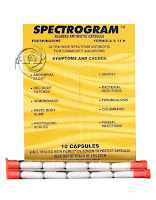
The most effective medication BAR NONE for the treatment of Columnaris in an aquarium when used as part of the four step program of Columnaris treatment.
A more synergistic combination than purchasing Kanamycin & Nitrofurazone separately.
AAP Spectrogram; Synergistic Kanamycin/Nitrofurazone
AAP Bettamax; Synergistic Nitrofurazone/Methylene Blue/Sulfas Full Spectrum Treatment for Bettas

Everything you need to know about Sponge Filtration

Atison's Spa Clear; Indian Almond Leaf Conditioner
Clear Betta Spa contains wild almond leaf extract to simulate the natural environment of the native soft water fish.
Other natural botanicals, including Yucca extract, help control ammonia, reduce stress and maintain cleaner water.
Betta Specifics, Information

FISH AS PETS
Fish as Pets with articles & commentary of Interest to the Aquarium Hobby

A great forum for all your fish questions
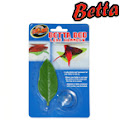
ZooMed Betta Hammock
Allows your Betta to rest near the surface of the water just like they do in nature.
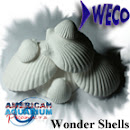
Wonder Shells; Regular & Medicated
Provides a constant supply of ESSENTIAL mineral ions for Bettas and other fish.
These unique Wonder Shell Mineral Supplements are sold EXCLUSIVELY at American Aquarium Products

Sanyu Betta Gold Premium Betta Pellets
* To reinforce the color combination of bettas by high percentage of natural color pigment.
* Strongly outline the original color combination of bettas
* It contains all the nutrition to keep the betta in good health
* Extremely stable vitamin C helps promote effective growth by reducing stress and reinforcing resistance
* A quality Betta food at a better value.
ADVERTISEMENT
Labels: Betta, Betta Aquarium, Betta Bowl Size, Betta Care, Betta Habitat, Betta Keeping, Betta Tank, Chao Phraya River, Mekong River, Plaket
Dropsy in Fish; Swollen Betta, Kidney Infection, Osmoregulation
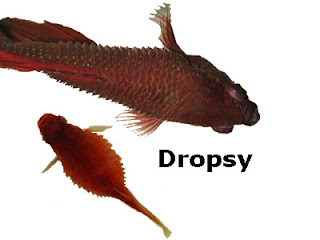 DROPSY in fish; prevention, causes, and possible treatment of this malady that is often a symptom of other problems.
DROPSY in fish; prevention, causes, and possible treatment of this malady that is often a symptom of other problems.
By Carl Strohmeyer
Updated 11/24/21
BACKGROUND:
I've been professionally treating many fish diseases, conditions & syndromes since 1978.
Dropsy is a condition I've treated for clients many times over the decades and discussed with other leading professionals at seminars too often at seminars and industry trade shows.
What is Dropsy?
Dropsy is basically a "Condition" or "Syndrome".
In other words a symptom with many causes, often a mix of causes such as diet, osmoregulation, bacterial pathogens such as Aeromonas and generally affecting the kidneys.
As noted, most often Dropsy is Kidney related, which results in swelling and fluid retention due to poor kidney function results in the classic "pinecone" look of fish sick with Dropsy.
Poor osmoregulation is usually the second most common cause, followed by diet, and in more rare instances digestive, and maybe liver malfunction/infections.
Often it is a combination of infection of the kidney, poor osmoregulation (including oxidative stress), and poor diet (which often is the result of too high energy levels and poor protein optimization).
The loss of ability for osmo-regulation of electrolytes is often a contributing cause, which is another reason for correct positive mineral ion and trace element levels.
Please see these two articles:
*Aquarium Chemistry; Calcium, Electrolytes, GH, KH, & more
*Do Fish Drink; Proper Osmotic Function .
COMMENTARY:
Sadly a person who may or may not have some expertise is posting on YouTube video comments (including AAPs channel) touting his experience with API (a known discounter of limited aquarium medications, certainly not a seller of higher end pharmaceutical grade products such as Aquatronics or SeaChem).
He attacked my experience and expertise on this subject calling it "True Dropsy" when in fact the industry has NEVER considered Dropsy a "True" disease (which is why I doubt his so called expertise and believe he is more likely an internet troll that are so common of late trying to make a name for himself posting on many YouTube channels dealing with this subject).
He also stated that True Dropsy is not curable. Well, since Dropsy is actually a condition and not a true disease per say (example would be Septicemia in fish which is also a condition with many possible causes), some causes of Dropsy can and as a MATTER OF FACT have been cured when caught in time. Unfortunately some causes are indeed incurable no matter what one does for their fish, and even if caught early on.
This is also why prevention (as you will read later in this article) is key, as I had very few cases of Dropsy of ANY cause when certain procedures were followed.
Generally due to the cause or area of infection (or organ failure), Dropsy can often be very difficult to treat, especially if caught in an advanced case in the fish (usually in advanced stages euthanasia is your best choice).
What the aquarist often observes is a “pinecone” swelling generally caused by fluid building inside the body cavity (often involving the Kidneys), for this reason, reducing this swelling is an important step in effecting a cure.
I have heard of Minocycline also being recommended for this (although it can be effective). I do not recommend this as Minocycline has been shown to cause serious damage to the kidneys, which is the last thing you want to do to a fish suffering from Dropsy or even suspected of this malady.
Information on Minocycline:
Use of Minocycline, Maracyn 2 for fish treatment
I would also note that since Aeromonas bacteria is a common cause of infections (along with the parasite Mitraspora cyprini, more commonly found in pond fish) that result in Dropsy and since this bacterium is often anaerobic; maintaining good circulation, aeration and overall good tank hygiene goes a long ways in treatment and even further for prevention (since Dropsy is difficult to treat and cure).
Please read more about optimum tank conditions in the prevention section further into this article, as I have been able to prevent Dropsy much more successfully (as per controlled tests) than actually treat a full blown case of Dropsy!.
Sometimes liver issues are blamed for Dropsy, which is certainly possible, however liver malfunction and infections generally do not result in the classic "pinecone" Dropsy appearance, rather the fish may bloat slightly and almost always results in loss of color, loss of appetite, and the fish tends to hide more.
One of the functions of the liver is to remove toxins and this is why the symptoms I describe are more prevalent with liver issues.
Generally if liver problems are the cause, successful treatment is rare
Other issues blamed for Dropsy include swelling for egg impaction, swim bladder issues, Mycobacterium Tuberculosis, & Costia.
However, while the later two in particular can be similar, based on my decades of practical experience dealing with Classic Dropsy these still do not produce the classic symptoms and more importantly treatment is quite different.
This said, besides treatment for a possible underlying infection, you want to take steps to remove the swelling.
ADVERTISEMENT
Here are the steps I would take to have chance at defeating the causes of Dropsy in less advanced stages.
ALL STEPS ARE IMPORTANT, Skipping even a couple lowers effectiveness considerably.
These steps apply to ALL fish, not just Bettas.
Success rate from my experience when ALL steps are followed (which is in the 100s of cases) is about 50%. But I must qualify this by stating that in cases where the fish is not eating and non responsive is closer to ZERO while in cases where the fish is responsive, eating and otherwise doing relatively well is much higher than 50%,
- Change water! (25% should be fine)
- Perform a medicated bath with Methylene Blue and AAP Naladin (Naladixic Acid), OR Metronidazole, OR Kanamycin, OR Sulfathiazole.
To prepare this bath I use double dose of Methylene Blue/MethyBlu that would be called for in a direct aquarium applications in a bath of aquarium water from the tank the fish you wish to treat came from, I usually use about a ½ gallon of water, however you may use less.
Measurement of the Methylene Blue does not need to be precise as this bath should be used for about 30 minutes.
Make sure you keep the water in a warm area, as in a cold room the water temperature can drop rapidly which would stress the fish.
Please Read:
*Medicated Fish Baths
As to the previously noted antibiotics or Sulfa Based Drugs (such as Sulfathiazole or Maracyn Plus), I GENERALLY have used twice the recommended in tank strength in these baths of the before mentioned medications (Metronidazole, etc.) with the possible exception of Kanamycin.
Keep in mind that Kanamycin, while not as toxic to kidneys as Minocycline, it is still toxic, yet is also very effective for infections of the kidneys! The point being is use with caution and do not use in the main aquarium, only in baths when fish have Dropsy so as to keep the exposure time low but effective (hence the double strength treatment in the short duration of a bath).
Recommended product links/references:
*AAP Methylene Blue
*AAP Premium MethyBlu
*AAP Naladin (Naladixic Acid)
*AAP/SeaChem Kanaplex
*AAP/Mardel Maracyn Plus
*AAP SulfaPlex Sulfathiazole
I STRONGLY recommend the use of salts in this bath as well at about double the normally used tank strength; 1-2 teaspoons sodium chloride (regular salt) per gallon and 1/8 to ¼ teaspoon Epsom salt per gallon of bath water.
Further Reading about sodium chloride salt use:
Salt/Sodium Chloride use in Freshwater Aquariums
Do NOT pour this water back into your display aquarium when finished!
This can be performed twice per day.
For further information (more in depth) about fish baths, please read this article:
Fish Baths/Dips for supplemental (& even primary) treatment of Bacterial infections - Add one tablespoon of regular salt (sodium chloride) per 5 gallons of aquarium/tank water or even 1 teaspoon per gallon if the fish will tolerate this (NOTE, this second dose is TEAspoon, NOT tablespoon.
Add a FRESH AAP Wonder Shell or similar product to add needed calcium and mineral cations (beware that the Wonder Shells sold via Amazon and other discounters are not only not an authorized product, but they are not fresh either, so the benefit of redox improving mineral Cations are lost).
What these minerals will do is add electrolytes and change (and improve) the osmotic balance of the fish vs. the surrounding water to hopefully pull fluids thru the body thus reducing swelling. Basically we are attempting to duplicate the balance osmotically with the fish' blood which is .9% salt
For more about electrolytes, please read this article: Aquarium Chemistry; Why calcium and electrolytes are important - Treat tank water with Kanamycin (Kanaplex), or possibly with Neomycin or AAP Naladin (Nalidixic Acid).
Also consider feeding the infected fish with fish food soaked in Neomycin such as Neoplex along with in tank treatment of Kanamycin (hospital tank is best).
Then add a Medicated Wonder Shell to the holding/hospital aquarium.
Other treatments of note are Minocycline (Maracyn II) and Metronidazole (SeaChem makes an excellent pure Metronidazole).
Further Reading: *Use of Kanamycin, Kanaplex in Aquariums, Ponds
Additional recommended product links/references:
*SeaChem Neoplex (Neomycin)
*SeaChem Metronidazole
Generally, a “cocktail” approach with more than one medication is necessary for "Classic" kidney related Dropsy, such as Kanacyn and Metronidazole OR Neomycin along with a Medicated Wonder Shell together (and this still includes the baths!!).
Please note that combining Metronidazole with Neomycin does not improve results, so this "cocktail" combination should ONLY be with Kanamyacin with EITHER Neomycin or Metronidazole along with a Medicated Wonder Shell.
OR just AAP Naladin (Nalidixic Acid) ALONG WITH a Medicated Wonder Shell! In fact Naladixic Acid is specific to kidney/urinary tract infections, so is an excellent choice for many of not most Dropsy causes!!
Sometimes the bath as prescribed earlier along with Kanamycin & a Medicated Wonder Shell is just enough to affect a cure (assuming a cure is even possible).
If Mitraspora cyprini is the root cause, the cocktail is more effective with either Naladixic Acid or Metronidazole being one of the "ingredients".
The advantage of using the AAP Medicated Wonder Shell™ is this is the only fish medication that combines medications that oxidize, all the while providing Redox reducers to fight oxidative stress, which with kidney and fluid retention problems is an important factor to consider.
Product Resources:
Medicated Wonder Shell
AAP Naladin (Naladixic Acid)
Sometimes raising water temperature to 82-84F can help, in particular if the cause is primarily osmoregulation. However if a bacterial pathogen is a part of the problem, this can actually make things worse.
Here is more info about aquarium medications:
AQUARIUM MEDICATIONS; treatments, how they work, and which ones to use and not to use - Another potential additional "natural" treatment that has been proven human use for digestive issue is Oregon Grape Root.
Suggested use is opening a 400 mg Oregon Grape Root Capsule into 10 gallons aquarium and/or fish bath water along with before suggested antibiotics.
For more about Oregon Grape Root use for aquarium/pond fish:
Aquarium Medications Part 4; Oregon Grape Root
PREVENTION:
The Aeromonas bacteria (that is often present in healthy aquariums) can cause infections that will manifest this way in poor water conditions, especially in aquariums with poor circulation and high amounts of DOC (dissolved organic compounds) along with a high "Bio-Load" as Aeromonas Bacteria can be anaerobic and thrive in low oxygen, high dissolved organics conditions.
Reference:
Aeromonas Infections in Fish
So maintaining a healthy aquarium with regular water changes, good filtration (if possible, as this is why I see more cases of Dropsy in Betta kept in a bowl), and maintaining optimum water parameters; Ammonia and nitrites 0, kH 50+ ppm, GH 100+ ppm, & nitrates under 40 ppm (the lower the better, so 20 ppm or less is better yet).
A water parameter that is often missed (as the more obvious ammonia and nitrites are usually noticed) is proper calcium and electrolytes (positive mineral cations). These mineral Cations help balance oxidative stress which can have an impact on Kidney function & fluid retention. This can be tested in rH/Relative Hydrogen Score with healthy aquariums should have a rH reading between 23 & 26
If RO or RO/DI is used (or drinking water that is nothing more than RO water with a few minerals added for “taste”), there are usually insufficient electrolytes and calcium for proper osmotic function and fluid retention can result, which will then lead to kidney infections. Make sure to properly re-mineralize if RO water is used
Please read these articles for more about this aspect of fish care:
*Proper Osmotic Function; Use of RO Water
*Aquarium Redox & rH
* AQUARIUM CHEMISTRY; The importance of Calcium, GH, KH, Magnesium to Fish
All this goes a long way in prevention of Dropsy and other diseases, especially when poor osmoregulation is the direct cause or even indirect cause of Dropsy.
By indirect I mean opportunistic infections getting a foothold internally in your fish due to poor levels mineral cations & buffers present in your aquarium water.
Use of true level one UV Sterilization..
Similar in benefits to mineral Cations, but not having a direct impact on osmoregulation, the use of level one UVC Sterilization lowers oxidative stress in the water column, which over time has a direct impact on fish health and longevity, including likelihood of issues that can result in Dropsy symptoms.
Reference:
*Aquarium/Pond UV Sterilization
A proper diet makes a large difference here.
Do not feed your fish "meat based" proteins. I recommend aquatic based proteins such as whole menhaden or white fish meal, shrimp or even the proteins found in spirulina algae.
As a basic Betta diet I recommend Sanyu or Hikari Betta Gold pelleted foods.
There are many other quality Betta foods as well, although I do not recommend flake foods for bettas as their staple diet.
However Flake Food such as Spirulina based Spirulina 20 are excellent when used as a "fish food slurry/soak" for frozen or freeze dried brine shrimp, worms or other carnivorous diet food that Bettas prefer
For other fish, fish food guru Clay Neighbor's AAP Custom Premium & Spirulina 20 are excellent staple diets (in fact, easily the best when the science of fish nutrition is applied including energy levels and fiber)).
Poor quality proteins (or better; unusable amino acids for fish) can lead to digestive problems or Renal failure, which CAN lead to the symptoms of Dropsy.
All proteins are made up of amino acids, some are usable (by fish), and some are not.
Those that are not are disposed of by kidneys in the fish. This can lead to renal failure or infection.
This is where highly digestible foods come in and more importantly fish food that optimize/limit their ingredients such as Clay Neighbor's Custom fish foods.
Unfortunately even among so-called premium fish foods, the common method is to utilize "the more the better" method of ingredients, in particular proteins. This can and DOES slowly result in kidney damage that can result in many opportunistic infections, including those that result in fish dropsy.
Oxidative stress to the kidneys over long periods of time by fish foods too high in energy levels is something to consider when looking to prevent Dropsy.
While changing to a better diet once a fish is diagnosed with dropsy is too little too late from my experience, changing to a better more optimized diet is certainly good prevention for dropsy and other fish diseases for your existing fish.
One of the few if only fish foods that truly optimize/limits ingredients is Clay Neighbor's "AAP Custom All Natural Optimized Fish Food" (there are a few copycats that do not know the exact formula that are not quite up to par here).
Also it is often a good idea to soak dry foods in water for 5 minutes prior to feeding as this will remove air that can lead to infections of the digestive tract (goldfish in particular).
For more information about proper nutrition, see this article:
"Fish Nutrition; What ingredients are needed for proper fish growth and health".
See also this section:
Fish Nutrition; FD/Frozen Foods Spirulina Slurry
Other suggested reading:
Spirulina Algae; The Aquatic Health Benefits for Tropical, Marine and Goldfish.
Fish Food Recommendations, product links:
*Clay Neighbor's "AAP Custom All Natural Optimized Fish Food" (includes Carnivore for Bettas)
*Spirulina 20 Fish Flake Food
*Hikari Betta Bio-Gold
*Hikari Spirulina Enhanced Brine Shrimp
The above is a VERY short list of quality, highly digestible fish food diets, so please read the article I suggested earlier about Fish Nutrition!!
To summarize prevention; I have seen very few cases of Dropsy in the literally 1000s of aquariums I have maintained in regular contracts over the years. This is because I followed ALL Steps outlined in the AAP Aquarium Disease Prevention Article, and the facts of this article speak for them self, especially when it comes to Dropsy.
Reference: Aquarium Disease Prevention
HOWEVER, I have seen MANY cases of "Classic" Dropsy (as well as Dropsy like problems) when non regular service customers call me out to see why their fish are sick and I often will observe very poor water conditions feeding practices, etc. (basically NOT following the steps in the article outlined above).
The reason is simple for my regular contract customers success, I have always maintained my tanks with regular cleanings, proper electrolyte levels, a balanced Redox, proper fish nutrition, and often UV Sterilization.
Other Recommended Reference & Product Sites
Our special formulation of Nitrofurazone, Sulfathiazole Sodium, Methylene Blue and sodium chloride.
Wide spectrum. Anti-microbial, anti-protozoan, anti-bacterial, anti-fungal. Good for newly arrived fish in quarantine situations.
Also good for healing wounds and ammonia burn on newly arriving fish. Works well for sores on fish in Koi ponds..
* “Aquarium Disease Prevention”
In controlled test/studies, the incidence of Dropsy was almost non-existent where all points outlined in the above Disease Prevention article were followed!!
*UV Sterilization, Sterilizer Use; The importance in fish disease prevention
*Freshwater Aquarium Care Basics & Information
*Aquarium Filtration Information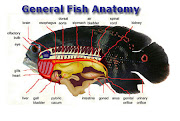 Fish Anatomy For further help in understanding the anatomy of fish (so as to know where the Kidneys are located), please read this article.
Fish Anatomy For further help in understanding the anatomy of fish (so as to know where the Kidneys are located), please read this article.
*Planaria & Detritus Worms in Aquarium
The best in Quartz, Under gravel, and Titanium Submersible Heaters:TMC V2 RO Filter systems; the very best you can buy with TDS meter:
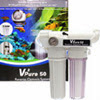 Reverse Osmosis Aquarium Water Filters; with TDS Meter
Reverse Osmosis Aquarium Water Filters; with TDS Meter
AAP AquaRay Ultra Premium Aquarium LED Lights
Highest in PUR, The ONLY LED with an IP67 rating or higher for water proofing along with a full 5 year warranty to back them up!
Why purchase brands without this rating such as the Finnex, Current, or Fluval only to be essentially placing an electronic light emitting device over your humid aquarium with little or no guarantee? In the long term, you WILL PAY MORE!
ADVERTISEMENT
Labels: Betta, Boby Fish, Dropsey, Dropsy, Fish Kidney Infection, Pinecone Fish, sick fish, Swollen Fish


